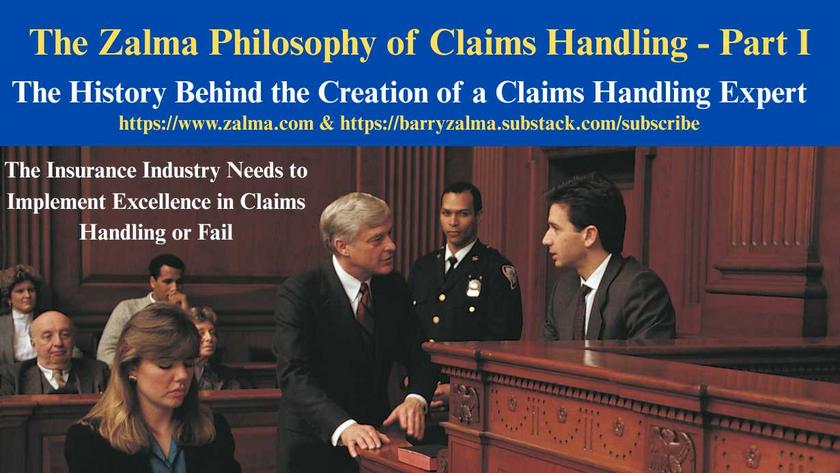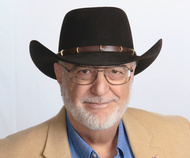
CONCURRENT CAUSE REQUIRES SEGREGATION OF COVERED FROM NON COVERED LOSSES
Barry Zalma
Jan 10, 2024
Read the full article at https://lnkd.in/gvpEHXi4 and sSee the full video at https://lnkd.in/gW5GBZpN and at https://lnkd.in/gsb8vKER and at https://zalma.com/blog plus more than 4700 posts.
Post 4707
Landmark Partners, Inc. (Landmark) sued Western World Insurance (Insurance) after it denied Landmark’s claim under an insurance policy. Landmark asserted claims for breach of contract, statutory violations, breach of common-law duties, and attorney’s fees and statutory interest. Relying in part on the testimony of Landmark’s own expert, Insurance moved for summary judgment on the ground that the concurrent causation doctrine defeated Landmark’s contractual claim, which in turn defeated Landmark’s other claims. The trial court granted summary judgment for Insurance, and Landmark appealed.
In Landmark Partners, Inc. v. Western World Insurance, No. 02-23-00116-CV, Court of Appeals of Texas, Second District, Fort Worth (December 28, 2023) the Court of Appeals applied the concurrent cause doctrine to resolve the dispute.
BACKGROUND
Landmark’s policy with Insurance covered damage to Landmark’s commercial property, but only for damage that commenced during the policy period, which began on February 4, 2020. The policy included coverage for hail and wind damage but no coverage for rain damage to the property’s interior unless the rain entered the building through damage caused by a covered event. After a storm on May 7, 2020, Landmark filed a claim with Insurance, requesting that Insurance provide coverage for damage to Landmark’s building, which Landmark alleged had been caused by the storm.
Insurance sent a contract field adjuster to inspect the property. That adjuster reported no signs of hail damage on the property’s roofing materials. Landmark hired a public adjuster who disagreed and put in proof for more than one million. Insurance then retained an engineer, Jarrod Burns, who did find some hail damage, particularly to some mechanical units on the roof, but he determined that the damage had been caused before the policy took effect. Insurance denied the claim.
Landmark sued Insurance for failing to provide coverage.
Insurance filed a motion for summary judgment based on the concurrent causation doctrine, which applies “when covered and excluded events combine to cause an insured’s loss.” If both covered and uncovered events combine to cause a loss, and the covered and uncovered events are inseparable, then causation is concurrent, the insurance policy’s exclusion applies, and the insurer owes no coverage for the loss.
Covered damage to the property could not be segregated from non-covered damage. The trial court signed a final judgment granting summary judgment for Insurance. Landmark appealed.
DISCUSSION
Because an insurer has no obligation to pay for damage caused by an event not covered under the policy, if covered and non-covered events combine to cause the damage, the insured must segregate between the damage attributable to the covered event and the damage attributable to other causes. Thus, Landmark would have to show at trial one of three circumstances:
1 that the damage had only one cause, which was covered by the policy;
2 that the damage had multiple independent causes, one of which was covered; or
3 although covered and non-covered events combined to cause the damage, Landmark had segregated between the covered damage and non-covered damage.
Landmark had the burden to show that the damage for which it sought coverage resulted from the May 2020 storm or another covered event. If Insurance’s summary judgment evidence established as a matter of law that segregation was impossible, Insurance was entitled to judgment unless Landmark responded with evidence raising a fact issue.
Because Insurance’s summary judgment evidence established that any damage caused by the May 2020 storm could not be segregated from the damage caused by previous storms that were not covered, Insurance demonstrated that it had no obligation to pay under the policy, thereby negating Landmark’s breach-of-contract claim.
Landmark failed to segregate between covered and non-covered damage or even raise the possibility that segregation could be done. Even under Landmark’s evidence, the covered and non-covered causes of property damage could not be separated.
Because Landmark’s evidence did not raise a fact issue sufficient to defeat summary judgment on Landmark’s contract claim, the Court of Appeal found no breach of contract.
EXTRACONTRACTUAL CLAIMS
In addition to its contract claim, Landmark alleged violations of Texas Insurance and breach of the common law duty of good faith and fair dealing in the context of processing and payment of insurance claims.
The Texas Supreme Court has explained, an insured cannot recover any damages based on an insurer’s statutory violation unless the insured establishes a right to receive benefits under the policy or an injury independent of a right to benefits.
As for Landmark’s common-law bad-faith claim, that, too, was negated by the summary judgment evidence.
Having overruled Landmark’s five issues, the Court of Appeals affirmed the trial court’s judgment.
ZALMA OPINION
Without a right to the benefits of a policy of insurance there can be no right to bad faith tort damages. Landmark failed to establish a right to the benefits of the contract of insurance because it could not segregate covered damages from damages that preceded the policy. No coverage no right to claim bad faith damages for improper claims handling.
(c) 2024 Barry Zalma & ClaimSchool, Inc.
Please tell your friends and colleagues about this blog and the videos and let them subscribe to the blog and the videos.
Subscribe to my substack at https://barryzalma.substack.com/publish/post/107007808
Go to Newsbreak.com https://www.newsbreak.com/@c/1653419?s=01
Go to X @bzalma; Go to the podcast Zalma On Insurance at https://podcasters.spotify.com/pod/show/barry-zalma/support; Go to Barry Zalma videos at Rumble.com at https://rumble.com/c/c-262921; Go to Barry Zalma on YouTube- https://www.youtube.com/channel/UCysiZklEtxZsSF9DfC0Expg; Go to the Insurance Claims Library – http://zalma.com/blog/insurance-claims-library.
Please tell your friends and colleagues about this blog and the videos and let them subscribe to the blog and the videos.
Go to X @bzalma; Go to Barry Zalma videos at Rumble.com at https://lnkd.in/gV9QJYH; Go to Barry Zalma on YouTube- https://lnkd.in/g2hGv88; Subscribe to my substack at https://lnkd.in/gcZKhG6g;
Go to the Insurance Claims Library – https://lnkd.in/gwEYkxD.
Louisiana Statute Prevents Enforcement of Contract Term Requiring Arbitration of Disputes
Post 5241
Read the full article at https://www.linkedin.com/pulse/international-convention-requiring-enforcement-award-barry-sttdc, see the video at and at and at https://zalma.com/blog plus more than 5200 posts.
In Town of Vinton v. Indian Harbor Insurance Company, Nos. 24-30035, 24-30748, 24-30749, 24-30750, 24-30751, 24-30756, 24-30757, United States Court of Appeals, Fifth Circuit (December 8, 2025) municipal entities including the Town of Vinton, et al sued domestic insurers after dismissing foreign insurers with prejudice. The insurers sought arbitration under the Convention on the Recognition and Enforcement of Foreign Arbitral Awards (the “Convention”) but the court held Louisiana law — prohibiting arbitration clauses in such policies—controls, as the Convention does not apply absent foreign parties who ...
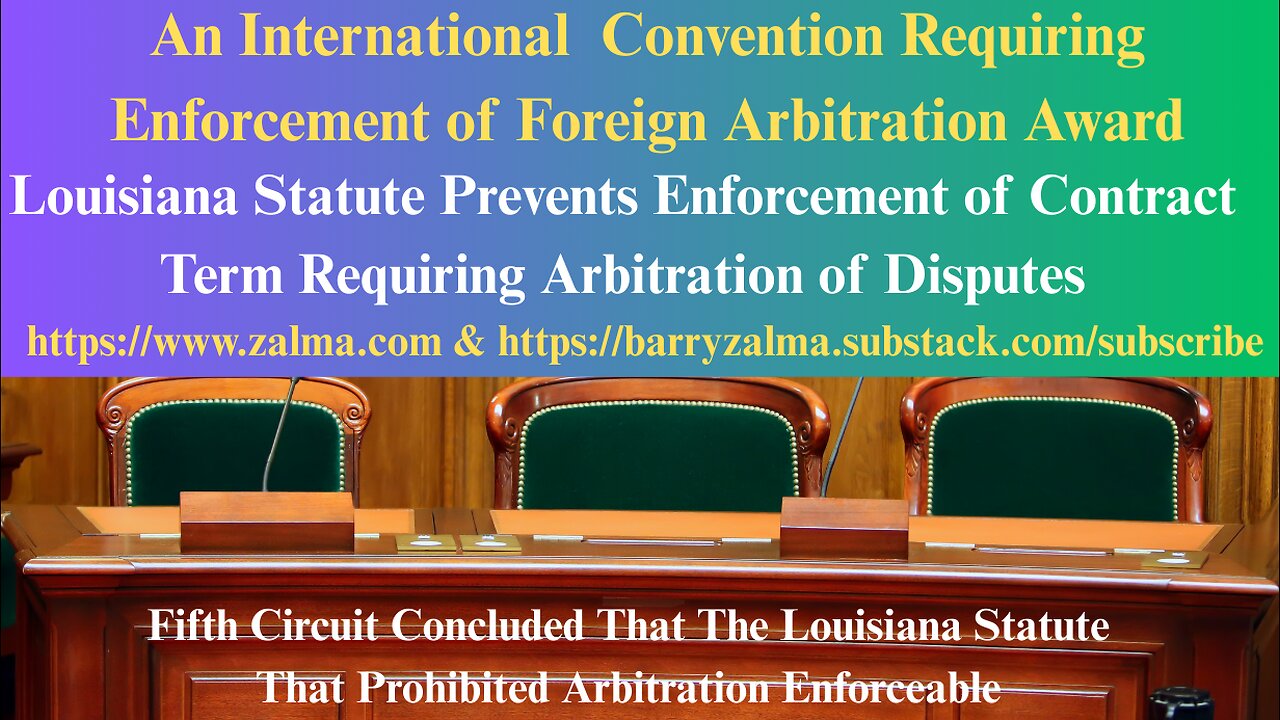
Refusal to Provide Workers’ Compensation is Expensive
Post 5240
Read the full article at https://lnkd.in/guC9dnqA, see the video at https://lnkd.in/gVxz-qmk and at https://lnkd.in/gUTAnCZw, and at https://zalma.com/blog plus more than 5200 posts.
In Illinois Department of Insurance, Insurance Compliance Department v.USA Water And Fire Restoration, Inc., And Nicholas Pacella, Individually And As Officer, Nos. 23WC021808, 18INC00228, No. 25IWCC0467, the Illinois Department of Insurance (Petitioner) initiated an investigation after the Injured Workers’ Benefit Fund (IWBF) was added to a pending workers’ compensation claim. The claim alleged a work-related injury during employment with the Respondents who failed to maintain workers’ compensation Insurance.
Company Overview:
USA Water & Fire Restoration, Inc. was incorporated on January 17, 2014, and dissolved on June 14, 2019, for failure to file annual reports and pay franchise taxes. It then operated under assumed names including USA Board Up & Glass Co. and USA Plumbing and Sewer. The business ...
Arsonist Incompetently Moves Pro Se to Avoid Prison
Post 5239
Read the full article at https://lnkd.in/gRX8TfKn, see the video at https://lnkd.in/gY3Jvnqp and at https://lnkd.in/gRCaaf-3, and at https://zalma.com/blog plus more than 5200 posts.
In Christopher A. Barosh v. Morris Houser, et al., Civ. No. 22-0769, United States District Court, E.D. Pennsylvania (November 25, 2025) a convicted arsonist and insurance fraudster moved the USDC acting in Pro se filed Objections to Magistrate Judge Reid’s Recommendation that the US District Judge dismiss his § 2254 Petition to avoid jail.
BACKGROUND
In October 2005, Barosh set fire to his girlfriend’s Philadelphia home — some 25 hours before the cancellation of the property’s insurance policy. Several witnesses saw Barosh leaving the property shortly before the fire erupted. After the fire, Barosh made “two separate admissions of guilt.”
He attempted to pay an acquaintance to provide him with an alibi for the time of the arson. The eyewitnesses, brother, and ...
The Professional Claims Handler
Post 5219
Posted on October 31, 2025 by Barry Zalma
An Insurance claims professionals should be a person who:
Can read and understand the insurance policies issued by the insurer.
Understands the promises made by the policy.
Understand their obligation, as an insurer’s claims staff, to fulfill the promises made.
Are competent investigators.
Have empathy and recognize the difference between empathy and sympathy.
Understand medicine relating to traumatic injuries and are sufficiently versed in tort law to deal with lawyers as equals.
Understand how to repair damage to real and personal property and the value of the repairs or the property.
Understand how to negotiate a fair and reasonable settlement with the insured that is fair and reasonable to both the insured and the insurer.
How to Create Claims Professionals
To avoid fraudulent claims, claims of breach of contract, bad faith, punitive damages, unresolved losses, and to make a profit, insurers ...
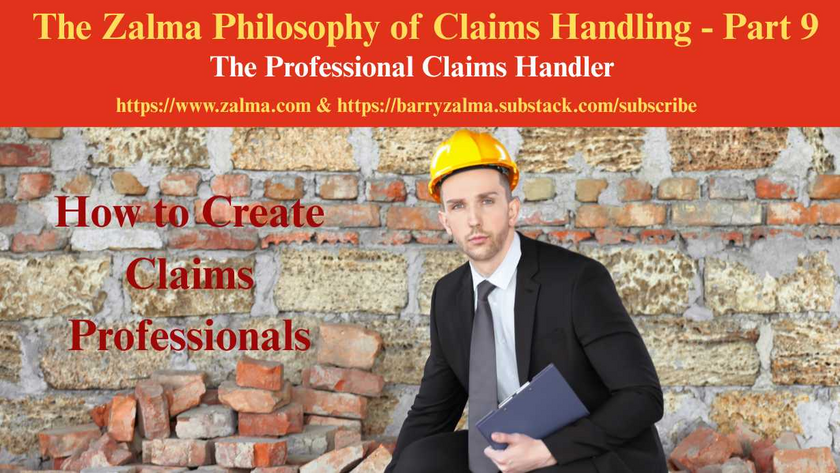
The History Behind the Creation of a Claims Handling Expert
The Insurance Industry Needs to Implement Excellence in Claims Handling or Fail
Post 5210
This is a change from my normal blog postings. It is my attempt. in more than one post, to explain the need for professional claims representatives who comply with the basic custom and practice of the insurance industry. This statement of my philosophy on claims handling starts with my history as a claims adjuster, insurance defense and coverage lawyer and insurance claims handling expert.
My Training to be an Insurance Claims Adjuster
When I was discharged from the US Army in 1967 I was hired as an insurance adjuster trainee by a professional and well respected insurance company. The insurer took a chance on me because I had been an Army Intelligence Investigator for my three years in the military and could use that training and experience to be a basis to become a professional insurance adjuster.
I was initially sat at a desk reading a text-book on insurance ...
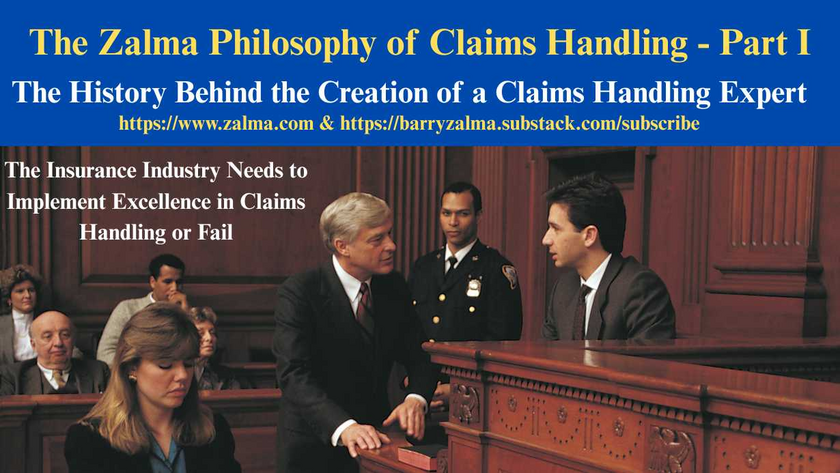
The History Behind the Creation of a Claims Handling Expert
The Insurance Industry Needs to Implement Excellence in Claims Handling or Fail
Post 5210
This is a change from my normal blog postings. It is my attempt. in more than one post, to explain the need for professional claims representatives who comply with the basic custom and practice of the insurance industry. This statement of my philosophy on claims handling starts with my history as a claims adjuster, insurance defense and coverage lawyer and insurance claims handling expert.
My Training to be an Insurance Claims Adjuster
When I was discharged from the US Army in 1967 I was hired as an insurance adjuster trainee by a professional and well respected insurance company. The insurer took a chance on me because I had been an Army Intelligence Investigator for my three years in the military and could use that training and experience to be a basis to become a professional insurance adjuster.
I was initially sat at a desk reading a text-book on insurance ...
